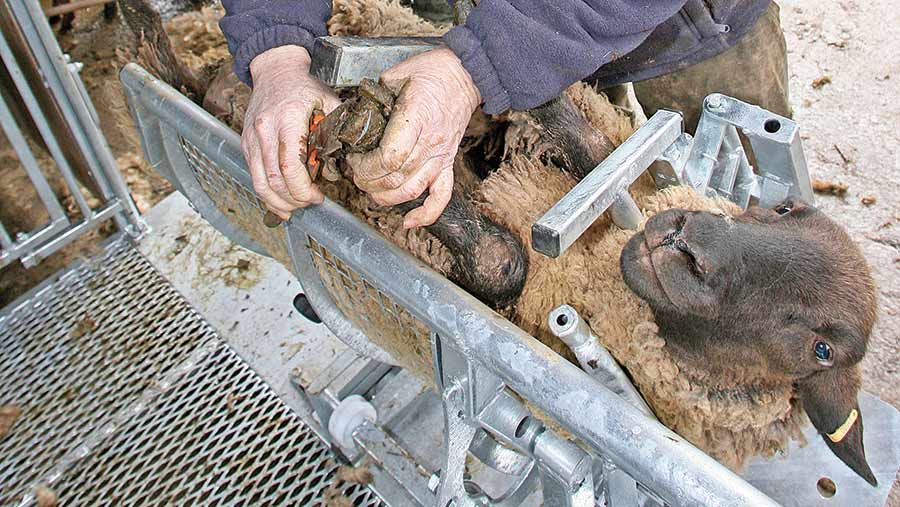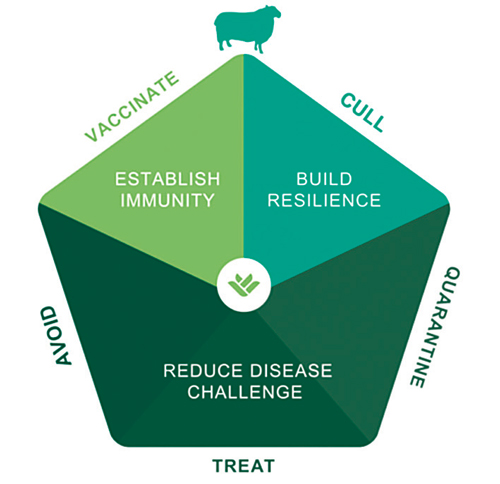Should you trim sheep’s feet to control lameness?
 © Richard Stanton
© Richard Stanton Foot-trimming is one of the first tasks many shepherds learn. However, we now know in most cases foot-trimming will make the problem worse.
Vet Emily Gascoigne from Synergy Farm Health dispels some of the myths associated with the practice and explains why routine foot-trimming can spread infection.
See more articles on sheep lameness:
- Sheep lameness: The successes and remaining challenges
- 4 ways to reduce sheep lameness to less than 2% by 2021
- How a sheep farmer has reduced lameness by 28%
- Advice on how to vaccinate sheep against foot-rot
- Step-by-step guide to foot-bathing sheep
- Should you trim sheep’s feet to control lameness?
- Advice for quarantining incoming sheep to prevent lameness
- How sheep farmer has reduced lameness to just 3%
What the research says
Foot-trimming doesn’t have a place for controlling lameness for the majority of lesions, which are infectious.
For contagious ovine digital dermatitis (CODD), foot-rot and scald foot-trimming may exacerbate the problem and can lead to the spread of infectious agents on the equipment and between sheep, research shows.
See also: 5 sheep crushes on test: Which handles best?
FAI Five-Point Plan

Toe granulomas are difficult to resolve and one of the risk factors we know of is overtrimming. Research found the use of foot-trimming delayed healing time in foot-rot infections.
The only time it is appropriate to trim is if you have a lame sheep with an impacted Shelly hoof lesion and no infected lesion.
This is where the white line is coming away and it creates a cave up the side wall of the impacted hoof.
It is far better to use your time inspecting the feet of sheep rather than spending this time trimming.
See also: How to correctly diagnose and treat the main causes of sheep lameness
Feet don’t need trimming
There’s evidence sheep regulate their own horn length. I know lots of flocks that have removed routine foot-trimming and they don’t have lots of overgrown feet. By trimming, you could be promoting growth.
However, if an overgrown hoof is affecting mobility, a corrective trim may be needed.
If you do have sheep with misshapen feet, it’s worth considering foot conformation and how that can be corrected by better breeding decisions.
Your time can be used more effectively
Time is a precious resource on farm, and substituting “foot-trimming time” for “worm egg counting time” is more likely to preserve performance.
There are better things you can be doing on your farm and for your back than routinely trimming whole flocks. It takes a leap of faith not to trim, but a lot of flocks do manage without it.
Sponsor’s message

Through July and into August, MSD Animal Health, together with Farmers Weekly, will be highlighting how the FAI Five-Point Plan (5PP) gives sheep farmers a clear framework for managing lameness effectively. We will bring together recommendations from key stakeholders in the sheep farming community to provide best practice guidance and a range of practical tips.
Adoption of the 5PP will maintain progress towards the industry target of achieving <2% lameness (as per FAWC 2011) in the national flock by 2021. Widespread adoption of the 5PP will also help reduce the amount of antibiotics used by the sheep industry by at least 10% in line with the RUMA Targets Task Force 2017 recommendations.
For a healthy view of a sound flock, follow the Five-Point Plan:
- Cull – to build flock resilience
- Treat, Quarantine and Avoid – to reduce the disease challenge
- Vaccinate – to establish immunity
Further detailed advice and support is available from vet practices and SQPs in animal health trade outlets.
Thanks to MSD Animal Health, whose sponsorship made it possible to run the Sheep Lameness Roundtable 2019. Farmers Weekly had complete editorial control of this report.
